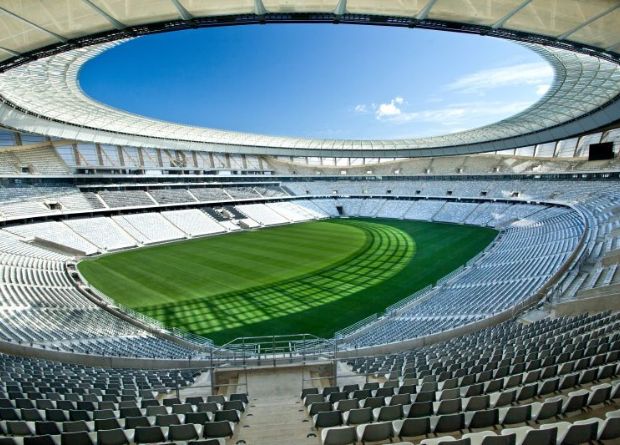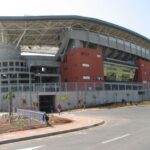Cape Town Stadium, located in the Green Point neighbourhood of Cape Town, South Africa, is a marvel of modern engineering and architectural design. The stadium was built for the 2010 FIFA World Cup and has since become a landmark in the city. The stadium is known for its unique design and engineering features, which make it one of the most advanced stadiums in the world.
The construction of Cape Town Stadium was a massive undertaking that required the latest in engineering and architectural design. The stadium has a seating capacity of over 68,000 and features a unique roof design that allows for natural light to enter the stadium while also protecting spectators from the sun. The stadium’s roof is made of a translucent laminated glass that protects against direct solar radiation, while the inner ring features clear glass that allows sunlight to reach the turf on the field.
Key Takeaways
- Cape Town Stadium was built for the 2010 FIFA World Cup and is a landmark in the city.
- The stadium’s unique roof design allows for natural light to enter while also protecting spectators from the sun.
- The stadium’s construction required advanced engineering and architectural design.
Architectural Design

Cape Town Stadium is a world-class facility that was designed to host the 2010 FIFA World Cup. The stadium’s architectural design is a marvel in itself, with its unique shape and innovative construction features. The following subsections will explore the stadium’s layout, roof structure, and facade elements.
Stadium Layout
The stadium has a circular design that is reminiscent of an African pottery bowl. The circular design ensures that there are no bad seats in the house, and every spectator has a clear view of the field. The stadium has a seating capacity of 68,000, and the seats are arranged in a bowl shape that slopes down towards the pitch. The lower tier of the stadium is closest to the field, and the upper tier is further away.
Roof Structure
The Stadium’s roof is one of its most striking features. The roof is a combination of a suspended roof with a radial truss structure, which gives the stadium its unique shape. It is covered in a fiberglass fabric that changes color depending on the lighting conditions. The roof also has a series of triangular openings that allow natural light to enter the stadium.
Facade Elements
The facade of the Cape Town Stadium is made up of a series of vertical panels that are arranged in a wave-like pattern. The panels are made of a translucent material that allows natural light to enter the stadium. The facade also has a series of horizontal louvers that help to regulate the temperature inside the stadium. The louvers can be adjusted to allow more or less natural light into the stadium, depending on the weather conditions.
In conclusion, the architectural design of the Cape Town Stadium is a testament to the creativity and innovation of its designers. The stadium’s circular layout, unique roof structure, and innovative facade elements make it one of the most iconic stadiums in the world.
Engineering Marvels

Cape Town Stadium is an engineering marvel that has received worldwide recognition for its innovative design and construction. The stadium was built for the 2010 FIFA World Cup and has since become an iconic landmark of the city. The construction of the stadium involved several engineering feats that set it apart from other stadiums around the world.
Foundation and Support
The stadium’s foundation is one of its most impressive features. The stadium was built on a site that was previously a golf course, which meant that the soil was not suitable for building a large structure. To overcome this challenge, the engineers used a technique called “soil improvement,” which involved injecting cement into the soil to stabilize it. This allowed the stadium to be built on a solid foundation that could withstand the weight of the structure and the thousands of people who would attend events there.
Sustainability Features
Cape Town Stadium was designed with sustainability in mind. The stadium’s roof is made of a lightweight fabric that allows natural light to filter through, reducing the need for artificial lighting during the day. The roof is also designed to collect rainwater, which is used to irrigate the surrounding landscape. The stadium’s energy-efficient lighting system reduces energy consumption and carbon emissions. These sustainability features have earned the stadium a Green Star SA rating, which is the highest rating for sustainable buildings in South Africa.
Material Innovations
The stadium’s unique design is a result of the innovative use of materials. The roof is made of a lightweight, translucent fabric that allows natural light to filter through, creating a bright and airy atmosphere inside the stadium. The fabric is also durable and weather-resistant, making it ideal for use in a stadium. The stadium’s seating is made of a composite material that is lightweight and durable, making it easy to install and maintain. The use of these innovative materials has allowed the stadium to achieve a balance between form and function, creating a unique and memorable experience for visitors.
In conclusion, Cape Town Stadium is a remarkable engineering feat that showcases the best of innovative design and construction. From its solid foundation to its sustainable features and material innovations, the stadium is a testament to what can be achieved with the right engineering expertise and vision.
Also, check: Inside Moses Mabhida Stadium: Exploring the Construction Features
Frequently Asked Questions

What is the seating capacity of Cape Town Stadium?
Cape Town Stadium has a seating capacity of 55,000 people. It was designed to be a multi-purpose stadium and was built to host the 2010 FIFA World Cup. The stadium is located in the Green Point neighborhood of Cape Town, South Africa.
Who were the architects behind the design of Cape Town Stadium?
The design of Cape Town Stadium was a collaboration between German architects GMP Architekten and South African architects Louis Karol. The stadium was designed to be a modern, multi-purpose facility that would serve as a landmark for the city of Cape Town.
Can Cape Town Stadium accommodate cricket matches?
Yes, Cape Town Stadium can accommodate cricket matches. The stadium has a retractable roof that can be closed during inclement weather and can also be used to create a more intimate atmosphere for smaller events.
What were the overall costs associated with building Cape Town Stadium?
The initial budget for the construction of Cape Town Stadium was R2.9 billion, but the final cost was closer to R4.5 billion due to various factors such as scope creep and delays. Despite the cost overruns, the stadium has become an iconic landmark and a source of pride for the city of Cape Town.
What innovative materials were used in the construction of Cape Town Stadium?
The stadium’s roof is made of a lightweight, translucent material called ETFE (ethylene tetrafluoroethylene), which allows natural light to filter through and creates a unique visual effect. The stadium’s façade is made of a fiberglass fabric that changes color depending on the time of day and the angle of the sun. These materials were chosen for their durability, versatility, and aesthetic appeal.
What type of events does Cape Town Stadium host besides football?
The Stadium hosts a wide range of events besides football, including concerts, cultural festivals, and corporate events. The stadium has become a popular venue for large-scale events due to its central location, flexible design, and state-of-the-art facilities.



